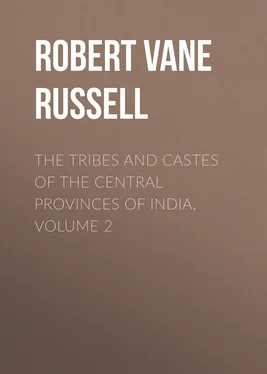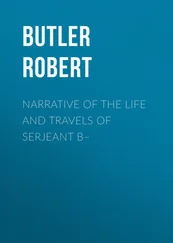Robert Vane Russell - The Tribes and Castes of the Central Provinces of India, Volume 2
Здесь есть возможность читать онлайн «Robert Vane Russell - The Tribes and Castes of the Central Provinces of India, Volume 2» — ознакомительный отрывок электронной книги совершенно бесплатно, а после прочтения отрывка купить полную версию. В некоторых случаях можно слушать аудио, скачать через торрент в формате fb2 и присутствует краткое содержание. Жанр: foreign_prose, История, foreign_edu, foreign_antique, на английском языке. Описание произведения, (предисловие) а так же отзывы посетителей доступны на портале библиотеки ЛибКат.
- Название:The Tribes and Castes of the Central Provinces of India, Volume 2
- Автор:
- Жанр:
- Год:неизвестен
- ISBN:нет данных
- Рейтинг книги:4 / 5. Голосов: 1
-
Избранное:Добавить в избранное
- Отзывы:
-
Ваша оценка:
- 80
- 1
- 2
- 3
- 4
- 5
The Tribes and Castes of the Central Provinces of India, Volume 2: краткое содержание, описание и аннотация
Предлагаем к чтению аннотацию, описание, краткое содержание или предисловие (зависит от того, что написал сам автор книги «The Tribes and Castes of the Central Provinces of India, Volume 2»). Если вы не нашли необходимую информацию о книге — напишите в комментариях, мы постараемся отыскать её.
The Tribes and Castes of the Central Provinces of India, Volume 2 — читать онлайн ознакомительный отрывок
Ниже представлен текст книги, разбитый по страницам. Система сохранения места последней прочитанной страницы, позволяет с удобством читать онлайн бесплатно книгу «The Tribes and Castes of the Central Provinces of India, Volume 2», без необходимости каждый раз заново искать на чём Вы остановились. Поставьте закладку, и сможете в любой момент перейти на страницу, на которой закончили чтение.
Интервал:
Закладка:
3. Religion, birth and death.
The Audhelias venerate Dulha Deo and Devi, to whom they usually offer pigs. Their principal festival is the Holi, at which their women were formerly engaged to perform as professional dancers. They usually burn their dead and remove the ashes on the third day, throwing them into the nearest stream. A few of the bones are picked up and buried under a pīpal tree, and a pitcher with a hole in the bottom is hung on the tree so that water may trickle down on to them. On the tenth day the caste-people assemble and are shaved and bathe and rub their bodies with oil under the tree. Unmarried men and persons dying of cholera are buried, the head being placed to the north. They consider that if they place the corpse in the reverse position it would be an insult to the Ganges equivalent to kicking the holy river, as the feet of the body would then be turned towards it.
Badhak
1. Introductory notice.
Badhak, Bāgri, Baoria.—A famous tribe of dacoits who flourished up to about 1850, and extended their depredations over the whole of Northern and Central India. The Bāgris and Baorias or Bāwarias still exist and are well known to the police as inveterate criminals; but their operations are now confined to ordinary burglary, theft and cheating, and their more interesting profession of armed gang-robbery on a large scale is a thing of the past. The first part of this article is entirely compiled from the Report on their suppression drawn up by Colonel Sleeman, 41 41 Report on the Badhak or Bāgri Dacoits and the Measures adopted by the Government of India for their Suppression , printed in 1849.
who may be regarded as the virtual founder of the Thuggee and Dacoity Department. Some mention of the existing Bāgri and Baoria tribes is added at the end.
2. The Badhak dacoits.
The origin of the Badhaks is obscure, but they seem to have belonged to Gujarāt, as their peculiar dialect, still in use, is a form of Gujarāti. The most striking feature in it is the regular substitution of kh for s . They claimed to be Rājpūts and were divided into clans with the well-known Rājpūt names of Solanki, Panwār, Dhundhel, Chauhān, Rāthor, Gahlot, Bhatti and Chāran. Their ancestors were supposed to have fled from Chitor on one of the historical occasions on which it was assaulted and sacked. But as they spoke Gujarāti it seems more probable that they belonged to Gujarāt, a fertile breeding-place of criminals, and they may have been descended from the alliances of Rājpūts with the primitive tribes of this locality, the Bhīls and Kolis. The existing Bāgris are of short stature, one writer stating that none of them exceed five feet two inches in height; and this seems to indicate that they have little Rājpūt blood. It may be surmised that the Badhaks rose into importance and found scope for their predatory instincts during the period of general disorder and absence of governing authority through which northern India passed after the decline of the Mughal Empire. And they lived and robbed with the connivance or open support of the petty chiefs and landholders, to whom they gave a liberal share of their booty. The principal bands were located in the Oudh forests, but they belonged to the whole of northern India including the Central Provinces; and as Colonel Sleeman’s Report, though of much interest, is now practically unknown, I have thought it not out of place to compile an article by means of short extracts from his account of the tribe.
In 1822 the operations of the Badhaks were being conducted on such a scale that an officer wrote: “No District between the Brahmaputra, the Nerbudda, the Satlej and the Himalayas is free from them; and within this vast field hardly any wealthy merchant or manufacturer could feel himself secure for a single night from the depredations of Badhak dacoits. They had successfully attacked so many of the treasuries of our native Sub-Collectors that it was deemed necessary, all over the North-Western Provinces, to surround such buildings with extensive fortifications. In many cases they carried off our public treasure from strong parties of our regular troops and mounted police; and none seemed to know whence they came or whither they fled with the booty acquired.” 42 42 Sleeman, p. 10.
3. Instances of dacoities.
Colonel Sleeman thus described a dacoity in the town of Narsinghpur when he was in charge of that District: 43 43 Sleeman, p. 10.
“In February 1822, in the dusk of the evening, a party of about thirty persons, with nothing seemingly but walking-sticks in their hands, passed the piquet of sepoys on the bank of the rivulet which separates the cantonment from the town of Narsinghpur. On being challenged by the sentries they said they were cowherds and that their cattle were following close behind. They walked up the street; and coming opposite the houses of the most wealthy merchants, they set their torches in a blaze by blowing suddenly on pots filled with combustibles, stabbed everybody who ventured to move or make the slightest noise, plundered the houses, and in ten minutes were away with their booty, leaving about twelve persons dead and wounded on the ground. No trace of them was discovered.” Another well-known exploit of the Badhaks was the attack on the palace of the ex-Peshwa, Bāji Rao, at Bithūr near Cawnpore. This was accomplished by a gang of about eighty men, who proceeded to the locality in the disguise of carriers of Ganges water. Having purchased a boat and a few muskets to intimidate the guard they crossed the Ganges about six miles below Bithūr, and reached the place at ten o’clock at night; and after wounding eighteen persons who attempted resistance they possessed themselves of property, chiefly in gold, to the value of more than two and a half lakhs of rupees; and retiring without loss made their way in safety to their homes in the Oudh forests. The residence of this gang was known to a British police officer in the King of Oudh’s service, Mr. Orr, and after a long delay on the part of the court an expedition was sent which recovered a portion of the treasure and captured two or three hundred of the Badhaks. But none of the recovered property reached the hands of Bāji Rao and the prisoners were soon afterwards released. 44 44 Sleeman, p. 57.
Again in 1839, a gang of about fifty men under a well-known leader, Gajrāj, scaled the walls of Jhānsi and plundered the Surāfa or bankers’ quarter of the town for two hours, obtaining booty to the value of Rs. 40,000, which they carried off without the loss of a man. The following account of this raid was obtained by Colonel Sleeman from one of the robbers: 45 45 Sleeman, p. 95.
“The spy ( hirrowa ) having returned and reported that he had found a merchant’s house in Jhānsi which contained a good deal of property, we proceeded to a grove where we took the auspices by the process of akūt (counting of grains) and found the omens favourable. We then rested three days and settled the rates according to which the booty should be shared. Four or five men, who were considered too feeble for the enterprise, were sent back, and the rest, well armed, strong and full of courage, went on. In the evening of the fourth day we reached a plain about a mile from the town, where we rested to take breath for an hour; about nine o’clock we got to the wall and remained under it till midnight, preparing the ladders from materials which we had collected on the road. They were placed to the wall and we entered and passed through the town without opposition. A marriage procession was going on before us and the people thought we belonged to it. We found the bankers’ shops closed. Thāna and Saldewa, who carried the axes, soon broke them open, while Kulean lighted up his torch. Gajrāj with twenty men entered, while the rest stood posted at the different avenues leading to the place. When all the property they could find had been collected, Gajrāj hailed the god Hanumān and gave orders for the retreat. We got back safely to Mondegri in two days and a half, and then reposed for two or three days with the Rāja of Narwar, with whom we left five or six of our stoutest men as a guard, and then returned home with our booty, consisting chiefly of diamonds, emeralds, gold and silver bullion, rupees and about sixty pounds of silver wire. None of our people were either killed or wounded, but whether any of the bankers’ people were I know not.”
Интервал:
Закладка:
Похожие книги на «The Tribes and Castes of the Central Provinces of India, Volume 2»
Представляем Вашему вниманию похожие книги на «The Tribes and Castes of the Central Provinces of India, Volume 2» списком для выбора. Мы отобрали схожую по названию и смыслу литературу в надежде предоставить читателям больше вариантов отыскать новые, интересные, ещё непрочитанные произведения.
Обсуждение, отзывы о книге «The Tribes and Castes of the Central Provinces of India, Volume 2» и просто собственные мнения читателей. Оставьте ваши комментарии, напишите, что Вы думаете о произведении, его смысле или главных героях. Укажите что конкретно понравилось, а что нет, и почему Вы так считаете.












